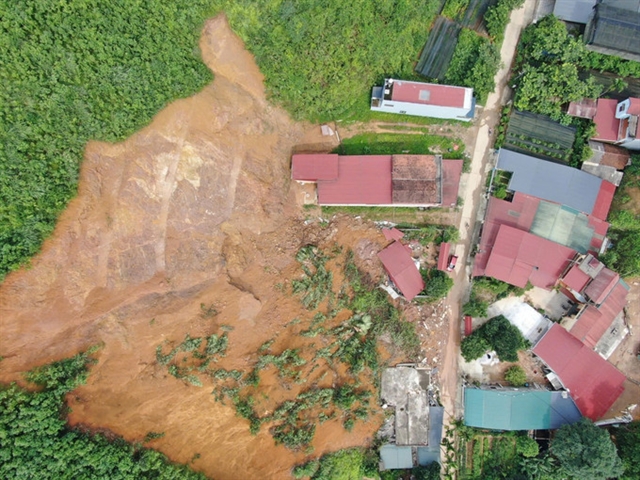 Society
Society

 |
| Many areas in Lào Cai Province are prone to landslides every time it rains. VNA/VNS Photo |
LÀO CAI As the northern region enters the rainy season, many households living at the foot of mountains and hills in Lào Cai Province are gripped by constant fear and anxiety over the risk of landslides and floods.
Local authorities are actively implementing various measures to minimise the damage caused by natural disasters.
Many families live beneath steep hillsides in Group 16 of the Đồng Tâm residential area of Yên Bái Ward.
This area experienced a serious landslide in September 2024 following Typhoon Yagi.
Nearly a year later, residents still live in a state of constant unease due to unpredictable weather patterns and ever-present landslide risks.
The neighbourhood was once densely populated and peaceful.
Now, however, many families have put their houses up for sale and abandoned their homes.
Others remain but live in fear, especially during prolonged heavy rains.
Resident Nguyễn Quang Du said: “I thought once the house was built, we’d finally have a new life, a proper shelter from sun and rain. But for us, when it rains, instead of staying inside, we have to run out and take shelter at someone else’s house. It’s very exhausting.”
Đặng Văn Quyền, head of the Group 16 residential area, said that more than 30 households in the area are located in high-risk landslide zones.
He expressed hope that the Party, the State and relevant agencies would consider a long-term relocation plan to help residents settle safely.
Similarly, in the Minh Tân 7 residential area, Đỗ Thế Thân's household and over 40 others are facing the same situation, as their homes lie directly beneath talus slopes.
Due to his age and challenging economic conditions, Thân can only evacuate temporarily during heavy rain.
“Local authorities and organisations regularly visit and encourage us to remain alert. Whenever there’s a warning or alert, we are ready to evacuate. But we can't continue living like this forever,” he said.
“We hope the Party, the State and Lào Cai Province will help us relocate to a safer place, where we can live in peace.”
Residents of Lương Thịnh Commune build their homes at the base of hills due to the mountainous terrain.
Phạm Thị Chanh, a resident of the commune's Khang Chinh hamlet, said her house lies directly under a talus slope.
On rainy nights, she and her husband have to sleep at their son’s house for safety.
Recently, signs of an imminent landslide have appeared behind the house, and water has begun to seep into the structure, leaving the couple anxious and sleepless.
“We just hope the authorities can arrange a safer place for us soon,” she said.
Yên Bái Ward currently has 30 high-risk landslide zones affecting nearly 80 households.
Since the two-tier local government system began operating, the ward has prioritised not only administrative streamlining, but also disaster prevention and response.
Chairman of the People’s Committee of Yên Bái Ward Phùng Tiến Thanh said the ward has strengthened its Steering Committee for Natural Disaster Prevention and Search and Rescue, assigning specific tasks to each member to ensure an effective response during storms.
Authorities have identified landslide-prone areas and proactively relocated residents to safer locations. Construction contractors have also been required to move all camps, workers, equipment and machinery out of danger zones to prevent flood-related damage, he said.
The ward has reviewed its inventory of disaster response equipment and materials to minimise losses. In the long term, it plans to identify specific households that need relocation and propose that the province allocate safe resettlement land outside disaster-prone areas.
Long-term solutions needed
Lào Cai is a mountainous northern province with a natural area of nearly 13,257sq.m and a population of over 1.7 million.
The terrain is complex, with strong elevation differences, steep slopes and severe fragmentation.
Over 107 large and small streams flow through the province, including major rivers like the Red River and the Chày River, which often bring floodwaters from China.
As a result, Lào Cai frequently experiences 19 out of 22 types of natural disasters, including cold spells, thunderstorms, heavy rain, landslides and flash floods.
In the first seven months of this year, natural disasters in the province claimed six lives and injured four others.
Disasters damaged 1,151 homes, destroyed over 396 hectares of rice and crops, killed 275 livestock and poultry and caused landslides at four schools and damage to 17 irrigation structures.
The total estimated losses exceed VNĐ25.8 billion.
Chairman of the Lào Cai Provincial People’s Committee Trần Huy Tuấn said the province has proactively implemented various disaster prevention and response measures to mitigate human and material losses. Disaster risk reduction has been integrated into socioeconomic planning and infrastructure development projects, especially in transportation and education.
The province is also working to improve disaster forecasting, aiming for timely and accurate early warnings. Lào Cai has mobilised private resources to install dedicated monitoring systems, including rainfall and water-level gauges and early warning systems for landslides, he said.
To reduce future losses from natural disasters, Lào Cai has proposed that the central Government and relevant ministries improve the accuracy of flood and landslide risk zoning maps.
These tools will help localities with land-use planning, safe resettlement and proactive disaster preparedness.
The province has also called for support in providing equipment, software for disaster monitoring and early warning and automatic reservoir management systems.
Alongside Government action, residents are urged to remain vigilant and evacuate to safer locations when heavy rains or landslides occur to ensure their own safety.
Locals are also advised to choose safe locations away from steep slopes when building new homes. VNS




